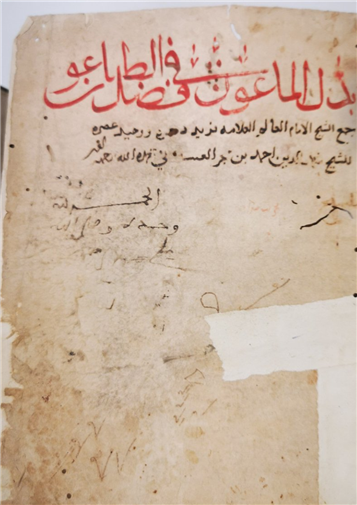
مخطوطة بذل الماعون في فضل الطاعون لأحمد بن علي بن محمد ( ابن حجر العسقلاني)

إن هذه المخطوطة تحفظ واحدة من أشهر الدراسات الطبية العربية في القرون الوسطى، وهي كتاب المنصوري في الطب، الدراسة التي ألفها أبو بكر محمد بن زكريا الرازي (865-925) الطبيب وعالم الطبيعة والفيلسوف والكيميائي الفارسي الشهير

كتاب القانون في الطب للحُسين بن عبد الله بن سينا (980-1037)، المعروف في اللاتينية باسم أفيسينا. كان المرجع المُعتمد في الطب خلال العصور الوسطى، ليس فقط في العالم الإسلامي ولكن، بترجماته اللاتينية، في أوروبا أيضاً

كتاب التيسير في المداوة والتدبير لأبو مروان عبد الملك ابن زهر (1090-1162)، أنجح الأطباء في إسبانيا الإسلامية. انقر هنا لقراءة النسخة اللاتينية من المكتبة الرقمية العالمية

The Black Death in the Middle East. By Michael W. Dols. Accessible through ACLS Humanities E-Book database.

Science in Medieval Islam : An illustrated introduction. By Howard R. Turner.
Comment les sociétés proche et moyen-orientales réagirent-elles face aux épisodes épidémiques qui touchèrent durement la région à travers l’histoire?
Par IFPO or Institut Français du Proche-Orient
Live Conversation with Dr. George Saliba, professor and director of Farouk K. Jaber Center of Arabic and Islamic Science and Philosophy at AUB. Wednesday, May 27, 2020.
|
This talk by Justin K Stearns reviews the diversity of views on contagion See also an article by the speaker on Plague and Contagion |
محمد أبطوي يحاضر حول اﻷوﺑﺌﺔ بين تاريخ الطب والتاريخ الثقافي والاجتماعي، 14 ايار 2020 ضمن سلسلة محاضرات "التفكير في أزمة كورونا وأبعادها"، التي يعقدها المركز العربي للأبحاث ودراسة السياسات دراسة الوباء وسبل التحرر منه: الاوبئة في الطب العربي وفي التاريخ الثقافي والاجتماعي |
What is Pandemic?
تعريف ومعنى الوباء كم وردت في قاموس المعاني
| للمزيد يمكنكم استعمال قاموس المعاني يعتبر قاموس المعاني قاموساً شاملاً يقدّم خدمات البحث في اللغة العربية بالاضافة الى خدمات الترجمة وإمكانية البحث بين اللغة العربية والعديد من اللغات الأخرى |
طاعون عمواس
يذكره المؤرخون على أنه أول طاعون في الإسلام، وكان في السنة الثامنة عشر من الهجرة، بدأ من منطقة عمواس (وهي بلدة في فلسطين تقع بين الرملة وبيت المقدس) ومنها انتشر إلى سائر بلاد الشام، فنُسب إليها
طاعون الفتيات / الاشراف
.كان في سنة السابعة والثمانين من الهجرة/706م، وقد سمي «الفتيات»؛ لأنه أول ما بدء بهن، وقد بدأ من البصرة أيضًا، واستمر بالانتشار إلى واسط والكوفة، ووصل حتى الشام وتسميه بعض المصادر بطاعون الأشراف
الموت الأسود(The Black Death)
من المتواتر أن هذا الطاعون نجم في الصين وسار إلى سائر شرق آسيا، ثم آسيا الوسطى، وحملته السفن التجارية التي كانت تجوب أنحاء حوض البحر الأبيض المتوسط، فضرب المشرق العربي، ووصل إلى بقية أوروبا، ومنها إلى شمال أفريقيا. ويُرجح أن هذا الوباء استمر عدة أعوام. ازداد خطراً وتفشياً في سنة 749ه/1348م، وأصبح عاماً وشاملاً فلم يترك مكاناً في الأرض إلّا حل به
Additional Resources:
